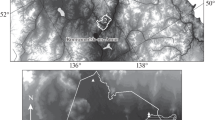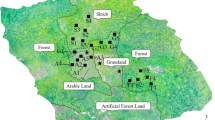Abstract
At three study sites, representing Mediterranean, semi-aridand mildly-arid climatic conditions, the effect of shrubs onthe spatial patterns of soil moisture was studied. At eachsite soil moisture was measured, on hillslopes, at thevicinity of 8 shrubs. For each shrub the measurements havebeen taken at 3 microenvironments, i.e. under the shrub (US),at the margins of shrub (MS) and between shrubs (BS). At themicroenvironments US and MS the measurements were taken at 3 directions: upslope, downslope and sideslope of the shrubs. At all sampling points soil samples were taken from 3 depths: 0–2, 2–5 and 5–10 cm. In addition, rock fragments cover percentage near the shrubs was determined. A soil moisture pattern was found, around each shrub,which is composed of a radial gradient and a downslope gradient. The radial gradient is expressed by soil moisture decreasingfrom the US microenvironment, in all directions, through the MS towards the BS microenvironment. The US microenvironmenthas a `spatial advantage' of higher soil moisture content dueto (1) relatively higher infiltration rate, (2) capture overlandflow from the BS area upslope that shrub and (3) low evaporationrate because of the shading effect.The downslope gradient is expressed by decreasing soil moisturefrom the upslope direction of each shrub (MS and US microenvironments) towards the downslope direction of that shrub (MS and US microenvironments, respectively). Thisgradient is controlled by the relatively high content of rockfragments near the shrubs at their upslope direction. Suchrock fragments spatial distribution is attributed to (1) thedetachment and transport of rock fragments by sheep and goatstrampling and (2) the effect of shrub on the continuity ofoverland flow and sediment transport. The effect of rockfragments is similar to that of shrubs regarding increasinginfiltration and decreasing evaporation rate. The relativelyhigh soil moisture at the upslope direction of each shrubenhances annuals growth producing a positive feedback loop:soil moisture – annuals growth – trampling. This sequencemaintains the typical rock fragments spatial organization andcontributes to the sustainability of the grazing system.At all the study sites at the US microenvironment there isa trend of decreasing soil moisture with increasing soildepth. At microenvironments MS and BS soil moisture increaseswith soil depth.The results are of great relevance for rehabilitationstrategies as they suggest that in order to combatdesertification in degraded semi-arid and mildly-arid areas,where the main land use is grazing, both shrubs and rockfragment should be kept at their present spatial distribution.
Similar content being viewed by others
References
Baver, L. D., Gardner,W. H. and Gardner, W. R.: 1972, Soil Physics, John Wiley & Sons, New York.
Belsky, A.J., Amundson, R. G., Duxburg, J. M., Riha, S. J., Ali, A. R. and Mwonga, S. M.: 1989, ‘The effects of trees on their physical, chemical and biological environments in a semi-arid savanna in Kenya’, J. Appl. Ecol. 26, 1005–1024.
Bochet, E., Rubio, J. L. and Poesen, J.:1999, ‘Soil stability islands within a Mediterranean patchy vegetation’, Catena 38, 23–44.
Brakensiek, D. L. and Rawls,W. J.:1994, ‘Soil Containing Rock Fragments: Effects on Infiltration’, in J. Poesen and H. Lavee (eds.), Rock Fragments in Soil: Surface Dynamics, Catena 23, pp. 99–110.
Duncan, D. B.: 1955, ‘Multiple range and multiple F-test’, Biometric 11, 1–42.
Govers, G. and Poesen, J.: 1998, ‘Field experiments on the transport of rock fragments by animal trampling on scree slopes’, Geomorph. 23(2–4), 193–203.
Hemming, C. F.: 1965, Vegetation acts in Somaliland, J. Ecol. 53, 57–67.
Hennessy, J. T., Gibens, R. P., Tromble, J. M. and Cardenas, M.: 1985, Mesquite (Prosopis glandulosa Torr.) dunes and interdunes in southern New Mexico: a study of soil properties and soil water relations, J. Arid Environ. 9, 27–38.
Imeson, A. C.: 1995, ‘The Physical, Chemical andBiological Degradation of the Soil’, in R. Fantechi, D. Peter, P. Balabanis and J. L. Rubio (eds.), Desertification in a European Context: Physical and Socio-Economic Aspects, CEE, Luxembourg. Proceedings of the European School of Climatology and Natural Hazards Course, Pueblo Acantilado, Alicante, Spain, 6–13th October 1993, pp. 153–169.
Lavee, H., Wieder, M. and Pariente, S.: 1989,‘Pedogenic indicators of subsurface flow on Judean Desert hillslopes’, Earth Surf. Process. Landforms 14, 545–555.
Lavee, H. and Poesen, J.: 1991, ‘Overland flow generation and continuity on stone-covered soil surfaces’, Hydrol. Process. 5, 345–360.
Lavee, H., Sarah, P. and Imeson, A. C.: 1996, ‘Aggregate stability dynamics as affected by soil temperature and moisture regimes’,Geografiska annaler 78A, 73–82.
Lavee, H., Sarah, P. and Perevolotsky, A.: 1997, ‘The effect of traditional grazing on eco-geomorphic properties in semi-arid areas in Israel’, Fourth Inter. Conf. Geomorph., Bologna Italy, Abstracts, p. 243.
Lavee, H., Imeson, A.C. and Sarah, P.: 1998, ‘The impact of climate change on geomorphology and desertification along a Mediterranean-arid transect’, Land Degrad. Develop. 9, 407–422.
Poesen, J.: 1986, ‘Surface sealing as influenced by slope angle and position of simulated stones inthe top layer of loose sediments’, Earth Surf. Process. Landforms 11, 1–10.
Poesen, J. and Lavee, H.: 1991, ‘Effects of sizeand incorporation of synthetic mulch on runoff and sediment yield from interrills in a laboratory study with simulated rainfall’, Soil Tillage Res. 21, 209–223.
Poesen, J. and Lavee, H.: 1994, ‘Rock fragments in top soils: significance and processes’, Catena 23, 1–28.
Poesen, J., Ingelmo-Sanchez, F. and Mucher, H.: 1990, ‘The Hydrological response of soil surfaces to rainfall as affected by cover andposition of rock fragments in the top layer’, Earth Surf. Process. Landforms 15, 653–671.
Puigdefabregas, J. and Sanchez, G.:1996, ‘Geomorphological Implications of Vegetation Patchiness on Semi-Arid Slopes’, in M. G. Anderson and S. M. Brooks (eds.), Advances in Hillslope Processes, Vol. 2, John Wiley & Sons, Chichester, pp. 1027–1060.
Sarah, P.: 1999, ‘Temporal andspatial variability of pedo-geomorphic processes as a response to changing climatic conditions along a topo-climatic transect between the Judean Mountains and the Dead Sea’, Ph.D. Thesis, Bar-Ilan University, Israel (in Hebrew).
Sanchez, G. and Puigdefabregas, J.: 1994,‘Interactions of plant growth and sediment movement on slopes in semi-arid environment’, Geomorph. 9, 243–260.
Sarig, S. and Steinberger, Y.: 1993, ‘Immediate effect of wetting event on microbial biomes and carbohydrate production-mediated aggregation in desert soil’, Geoderma 56, 599–607.
Schaefer, R.: 1973, ‘Microbial Activity Under Seasonal Conditions of Drought in MediterraneanClimates’, in Francesco di Castri and M. A. Harold (eds.), Mediterranean Type Ecosystems, Origin and Structure, Ecological Studies 7, Springer-Verlag, Berlin, pp. 191–198.
Schlesinger, W. H., Reynolds, J. F., Cunningham, G. L., Huenneke, L. F., Jarrell, W. M., Virginia, R. A. and Whitford, W. G.: 1990, ‘Biological feedbacks in global desertification’, Science 247, 1043–1048.
Thornes, J. B.: 1980, ‘Erosional Processes of Running Water and their Spatial and Temporal Controls: A Theoretical Viewpoint’, in M.J. Kirkby and R. P. Morgan (eds.), Soil Erosion, John Wiley & Sons, Chichester, pp. 129–182.
Valentin, C.: 1994, ‘SurfaceSealing as Affected by Various Rock Fragment Covers in West Africa’, in J. Poesen and H. Lavee (eds.), Rock Fragments in Soil: Surface Dynamics, Catena 23, pp. 87–97.
Yair, A. and Lavee, H.: 1976, ‘Runoff generative process and runoff yield from arid talus mantlesslopes’, Earth Surf. Process. Landforms 1, 235–247.
Author information
Authors and Affiliations
Rights and permissions
About this article
Cite this article
Pariente, S. Spatial Patterns of Soil Moisture as Affected by Shrubs, in Different Climatic Conditions. Environ Monit Assess 73, 237–251 (2002). https://doi.org/10.1023/A:1013119405441
Issue Date:
DOI: https://doi.org/10.1023/A:1013119405441




